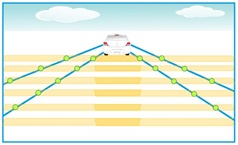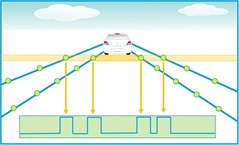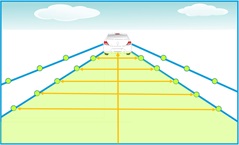The camera is of critical importance in today's glazing solutions. In this blog post, I’ll explain exactly how the camera works. In current vehicles, the lane departure warning system is almost standard equipment. This makes it even more important to understand why a camera calibration is mandatory after a windscreen replacement.
The lane departure warning system is an add-on to the electromechanical power steering system. With this type of steering, it is possible to transmit steering forces electronically and to support the driveability. To do this, it is necessary to implement a sensor that provides the relevant data: the camera.
At first glance, the camera does exactly what you expect it to do. It takes a picture of the lane ahead at regular intervals. Each individual image is processed by the camera control unit in almost real time. To enable this speed, the software divides the recorded area into two trapezoids that overlap in the centre (see image on the right-hand side).

In addition, the marked area is divided into individual lines. Line by line, the software analyses the differences in the grey levels. Let's consider a roadway with markings on left-hand and right-hand side. If the greyscale levels in a line differ significantly, the software places a marker at that location. Cameras can recognize up to 4096 different grey levels.

Once all lines have been scanned and the markings have been set, the software uses them to calculate the virtual lane. The image processing rate is 25 frames per second. The outer markings can be viewed as a secondary lane or the edge of the lane, depending on how the software works.

With this data, the vehicle determines its lateral position or lateral distance compared to the virtually generated lane. The camera control unit calculates the distance to the surrounding lane. This is based on the calibrated centre point from the geometric driving axis (see chapter 5) . If the lateral distance is too small, the vehicle either emits a warning tone or directly counter steers. Active counter steering is only found in a vehicle with an integrated lane departure warning system. A standard lane departure warning device only emits a warning tone.
What does it mean?
After replacing a windscreen with a camera system, a new camera calibration must be performed according to the manufacturer's specifications. The calibration is very important to enable the system to calculate the lateral distance correctly.
Often, the reason why the camera is not calibrated after the windscreen is replaced is because the warning light does not light up. This is because the system can work with incorrect parameters as long as the data seems plausible. In this example, the software adapts using the old parameters. To ensure that the system works correctly, it must be preceded by a recalibration so that it works with correct parameters. This ensures correct lane detection.